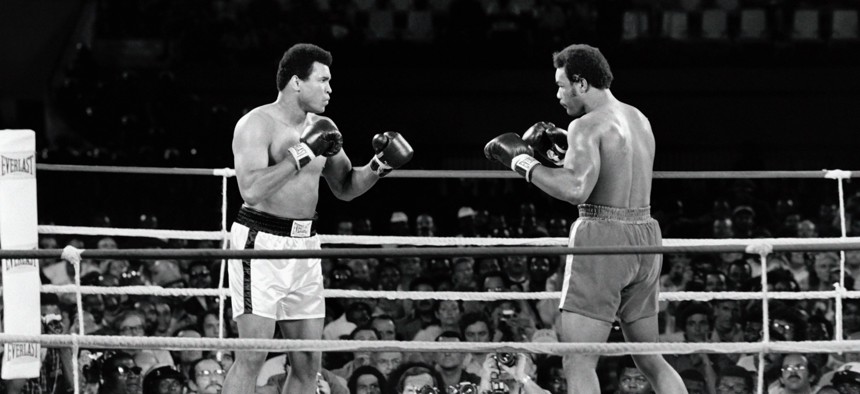Muhammad Ali’s Foreign Policy Lessons
Like the great boxer, America needs to know how to pick the time and place to engage.
Muhammad Ali, probably the greatest boxer of all time, adopted a signature strategy in his 1974 fight against George Foreman in Kinshasa, Zaire. During the so-called “Rumble in the Jungle,” Ali allowed himself to be pushed against the ropes, absorbing blow after blow, round after round. Most observers thought the hard-punching Foreman was winning the match. But Foreman began to tire by the fifth round, and he was exhausted by the eighth. Then, Ali unleashed a punishing barrage of punches to Foreman’s head that sent Foreman reeling. He stumbled to the mat, and the bout was over.
Ali didn’t share his strategy with his corner, and early in the fight, his trainers and cornermen were beginning to despair. Foreman had Ali on the ropes, just where he wanted him, and Ali was taking a pounding. It looked like Ali, who had surrendered the heavyweight title over his refusal to be drafted in the Vietnam war, would never get his championship back.
Ali had different plans. His genius was knowing when to lash out, and how. He seemed like a victim, but in fact he was picking his spots.
Around the world today, it is hard to know if the United States is more like Foreman or more like Ali. U.S. policy has been called everything from retrenchment, to restraint, overreach and decline, but the meaning is the same: the United States is a lot more like Foreman. But it doesn’t have to be that way.
It’s no wonder how the United States got to where it is. The 9/11 attacks were profoundly disorienting, and they drew the United States into a whole range of unfamiliar activities in the Middle East. Wars in Iraq and Afghanistan were expected to be quick, and each dragged on for more than a decade. A Global War on Terrorism supercharged U.S. special forces operations in unfamiliar terrain and kept creating more tasks that needed doing. A Forward Strategy of Freedom put democratization at the top of the U.S. diplomatic agenda in the Middle East, pressing governments to embrace liberalization and democracy, and encouraging civil society groups to seize the openings that were being created. Iran policy has been volatile, swinging from engagement to containment to confrontation and back again, leaving the Iranians, their neighbors, and the world wondering exactly where U.S. policy will be in the medium term.
While each of these efforts were understandable, and many were commendable, the U.S. government badly misjudged how much effort they would take and how successful they would be. The United States poured money and lives into the region, raising expectations at home and abroad.
The results were mixed. Deposing dictators in the Middle East didn’t create any durable democracies, but it did help touch off several civil wars. The Islamic State group gained and then lost territory, but it didn’t go away. President Donald Trump captured the public mood well when he complained that the United States’ biggest mistake was getting involved in the Middle East, having squandered seven—and later eight—trillion dollars trying to bring peace and security to the region. Meanwhile, as a senior Asian diplomat observed several years ago, for two decades, the United States was fighting without winning in the Middle East, and China was winning without fighting.
And all of America’s investment didn’t earn it much good will. The world looks at U.S. efforts to address Iraq, Iran, and Afghanistan, and they wonder whether the U.S. failure to achieve most of its goals is due to lack of will or lack of capacity. As an Arab friend put it to me this week, the United States has proven itself simultaneously indispensable and unreliable. The U.S. position is a far cry from what it was when the Cold War ended and U.S. troops led a broad international coalition to liberate Kuwait.
But the United States need not be consigned to the role of George Foreman, exhausted and staggering after too many rounds. Ali pointed to two things that are necessary.
The first is having a clear sense of what it is trying to do. Not enough hard choices have been made about what really matters, and what really doesn’t. Our policy process tends to produce long lists of co-equal priorities that are hard to oppose. The United States not only needs to prioritize, but it needs to have an affirmative vision of what it is trying to achieve, and not merely what it is trying to prevent.
The second is being able to control the flow of the engagement, and not merely to be reactive. As the three-time ambassador Ron Neumann pointed out to me recently, the United States is handling its very full policy agenda by managing problems and hoping they don’t turn to crises. It’s an understandable instinct, but it allows U.S. adversaries to pick the time, place and circumstances of U.S. engagements with them. Their skillful use of “gray zone” tactics and asymmetrical tools often means they are deriving incremental advantage while the United States is, in Ambassador Neumann’s memorable image, like a Chinese plate-spinning acrobat, keeping everything moving and hoping nothing crashes to the ground.
While Vladimir Putin started the Ukraine war on his terms, the Biden administration has done well to ensure that the Russian leader controls neither the pace nor trajectory of the war. Equally importantly, our intelligence effort appears tightly coordinated with the diplomatic and military ones.
The Middle East is a good place to adopt a more integrated strategy, and the most important place to do that is with Iran. While there is likely no durable solution to Iran’s instinct to be a regional spoiler, the United States needs to do a better job at presenting the Iranian government with clear choices, and to do so on U.S. terms. That requires a U.S. willingness to impose real costs on Iran, but also a willingness to recognize and reward better behavior, should it emerge.
Chasing after China’s rising Middle East presence, especially with President Xi’s expected visit next week, is a path of madness. Even as its regional roles grow, Bejing can’t compete with the U.S. ability to protect governments from external or internal threats—provided that Mideast leaders see their internal challenges as developing the human capital and management skills that they urgently need to face the energy transition, and not acquiring as much surveillance capacity as they can muster to repress their populations. The U.S. government needs to shift the terms of that conversation.
In addition, the United States needs to shrink its aperture. That means forming genuinely close relationships with a smaller number of countries and being willing to have more distant relationships with many. Being close to the United States should mean more, and being distant should mean more, too.
And finally, the United States needs to notch a real win or two, and not remain deeply entangled in every unresolvable problem in the region. Doing so—perhaps in Jordan, or Morocco, or elsewhere—would require full-spectrum engagement, and not just an enhanced security relationship.
At the end of the seventh round, not many people would have been willing to bet on Ali. But Ali knew what he was doing. The United States should, too.
Jon B. Alterman holds the Zbigniew Brzezinski Chair in Global Security and Geostrategy and directs the Middle East program at CSIS.





